Andrew W. Eckford
Energy Allocation for Multi-User Cooperative Molecular Communication Systems in the Internet of Bio-Nano Things
Apr 02, 2024



Abstract:Cooperative molecular communication (MC) is a promising technology for facilitating communication between nanomachines in the Internet of Bio-Nano Things (IoBNT) field. However, the performance of IoBNT is limited by the availability of energy for cooperative MC. This paper presents a novel transmitter design scheme that utilizes molecule movement between reservoirs, creating concentration differences through the consumption of free energy, and encoding information on molecule types. The performance of the transmitter is primarily influenced by energy costs, which directly impact the overall IoBNT system performance. To address this, the paper focuses on optimizing energy allocation in cooperative MC for enhanced transmitter performance. Theoretical analysis is conducted for two transmitters. For scenarios with more than two users, a genetic algorithm is employed in the energy allocation to minimize the total bit error rate (BER). Finally, numerical results show the effectiveness of the proposed energy allocation strategies in the considered cooperative MC system.
Signal Processing in the Retina: Interpretable Graph Classifier to Predict Ganglion Cell Responses
Jan 03, 2024



Abstract:It is a popular hypothesis in neuroscience that ganglion cells in the retina are activated by selectively detecting visual features in an observed scene. While ganglion cell firings can be predicted via data-trained deep neural nets, the networks remain indecipherable, thus providing little understanding of the cells' underlying operations. To extract knowledge from the cell firings, in this paper we learn an interpretable graph-based classifier from data to predict the firings of ganglion cells in response to visual stimuli. Specifically, we learn a positive semi-definite (PSD) metric matrix $\mathbf{M} \succeq 0$ that defines Mahalanobis distances between graph nodes (visual events) endowed with pre-computed feature vectors; the computed inter-node distances lead to edge weights and a combinatorial graph that is amenable to binary classification. Mathematically, we define the objective of metric matrix $\mathbf{M}$ optimization using a graph adaptation of large margin nearest neighbor (LMNN), which is rewritten as a semi-definite programming (SDP) problem. We solve it efficiently via a fast approximation called Gershgorin disc perfect alignment (GDPA) linearization. The learned metric matrix $\mathbf{M}$ provides interpretability: important features are identified along $\mathbf{M}$'s diagonal, and their mutual relationships are inferred from off-diagonal terms. Our fast metric learning framework can be applied to other biological systems with pre-chosen features that require interpretation.
Localization of a Passive Source with a Sensor Network based Experimental Molecular Communication Platform
Nov 28, 2023Abstract:In a practical molecular communication scenario such as monitoring air pollutants released from an unknown source, it is essential to estimate the location of the molecular transmitter (TX). This paper presents a novel Sensor Network-based Localization Algorithm (SNCLA) for passive transmission by using a novel experimental platform which mainly comprises a clustered sensor network (SN) with $24$ sensor nodes and evaporating ethanol molecules as the passive TX. In SNCLA, a Gaussian plume model is employed to derive the location estimator. The parameters such as transmitted mass, wind velocity, detection time, and actual concentration are calculated or estimated from the measured signals via the SN to be employed as the input for the location estimator. The numerical results show that the performance of SNCLA is better for stronger winds in the medium. Our findings show that evaporated molecules do not propagate homogeneously through the SN due to the presence of the wind. In addition, our statistical analysis based on the measured experimental data shows that the sensed signals by the SN have a log-normal distribution, while the additive noise follows a Student's t-distribution in contrast to the Gaussian assumption in the literature.
Terahertz Induced Protein Interactions in a Random Medium
Oct 23, 2023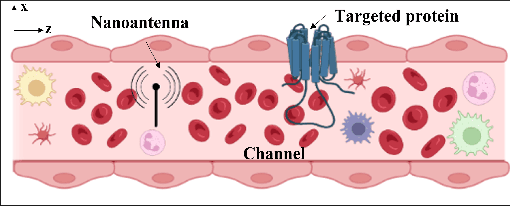
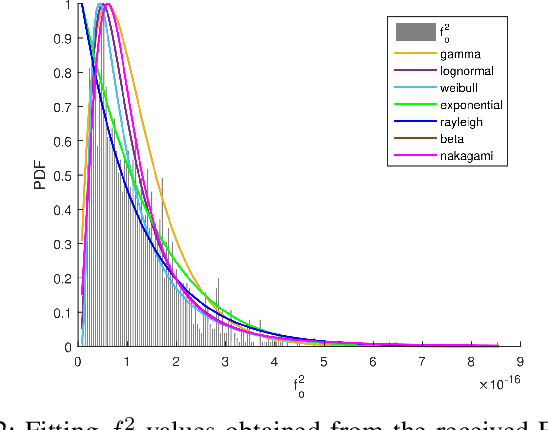
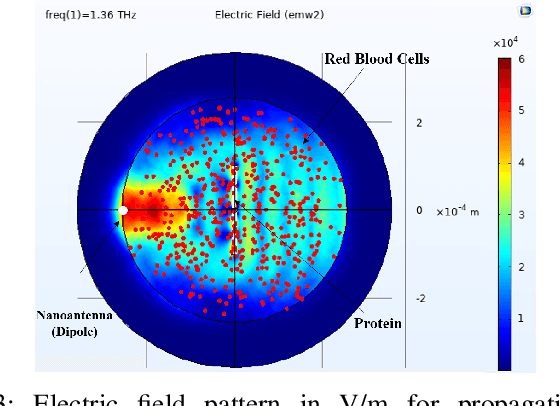
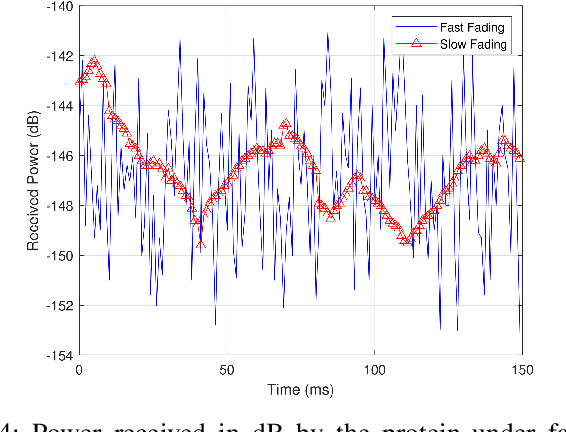
Abstract:Folding of proteins into their correct native structure is key to their function. Simultaneously, the intricate interplay between cell movement and protein conformation highlights the complex nature of cellular processes. In this work, we demonstrate the impact of Terahertz (THz) signaling on controlling protein conformational changes in a random medium. Our system of interest consists of a communication link that involves a nanoantenna transmitter, a protein receiver, and a channel composed of moving red blood cells. Due to the system dynamics, we investigate the influence of both the fast and slow channel variations on protein folding. Specifically, we analyze the system's selectivity to asses the effectiveness of the induced THz interaction in targeting a specific group of proteins under fading conditions. By optimizing the selectivity metric with respect to the nanoantenna power and frequency, it is possible to enhance the controllability of protein interactions. Our probabilistic analysis provides a new perspective regarding electromagnetically triggered protein molecules, their microenvironment and their interaction with surrounding particles. It helps elucidate how external conditions impact the protein folding kinetics and pathways. This results in not only understanding the mechanisms underlying THz-induced protein interactions but also engineering these still-emerging tools.
A Computational Approach for the Characterization of Airborne Pathogen Transmission in Turbulent Molecular Communication Channels
May 02, 2023Abstract:Airborne pathogen transmission mechanisms play a key role in the spread of infectious diseases such as COVID-19. In this work, we propose a computational fluid dynamics (CFD) approach to model and statistically characterize airborne pathogen transmission via pathogen-laden particles in turbulent channels from a molecular communication viewpoint. To this end, turbulent flows induced by coughing and the turbulent dispersion of droplets and aerosols are modeled by using the Reynolds-averaged Navier-Stokes equations coupled with the realizable $k-\epsilon$ model and the discrete random walk model, respectively. Via simulations realized by a CFD simulator, statistical data for the number of received particles are obtained. These data are post-processed to obtain the statistical characterization of the turbulent effect in the reception and to derive the probability of infection. Our results reveal that the turbulence has an irregular effect on the probability of infection, which shows itself by the multi-modal distribution as a weighted sum of normal and Weibull distributions. Furthermore, it is shown that the turbulent MC channel is characterized via multi-modal, i.e., sum of weighted normal distributions, or stable distributions, depending on the air velocity.
A Stochastic Biofilm Disruption Model based on Quorum Sensing Mimickers
Jan 30, 2023



Abstract:Quorum sensing (QS) mimickers can be used as an effective tool to disrupt biofilms which consist of communicating bacteria and extracellular polymeric substances. In this paper, a stochastic biofilm disruption model based on the usage of QS mimickers is proposed. A chemical reaction network (CRN) involving four different states is employed to model the biological processes during the biofilm formation and its disruption via QS mimickers. In addition, a state-based stochastic simulation algorithm is proposed to simulate this CRN. The proposed model is validated by the in vitro experimental results of Pseudomonas aeruginosa biofilm and its disruption by rosmarinic acid as the QS mimicker. Our results show that there is an uncertainty in state transitions due to the effect of the randomness in the CRN. The presented work shows how the biofilm growth and its disruption can be modeled realistically via the premature QS activation among bacteria.
Explicitly Solvable Continuous-time Inference for Partially Observed Markov Processes
Jan 02, 2023Abstract:Many natural and engineered systems can be modeled as discrete state Markov processes. Often, only a subset of states are directly observable. Inferring the conditional probability that a system occupies a particular hidden state, given the partial observation, is a problem with broad application. In this paper, we introduce a continuous-time formulation of the sum-product algorithm, which is a well-known discrete-time method for finding the hidden states' conditional probabilities, given a set of finite, discrete-time observations. From our new formulation, we can explicitly solve for the conditional probability of occupying any state, given the transition rates and observations within a finite time window. We apply our algorithm to a realistic model of the cystic fibrosis transmembrane conductance regulator (CFTR) protein for exact inference of the conditional occupancy probability, given a finite time series of partial observations.
Stochastic Modeling of Biofilm Formation with Bacterial Quorum Sensing
Dec 12, 2022



Abstract:Bacteria generally live in complicated structures called biofilms, consisting of communicating bacterial colonies and extracellular polymeric substance (EPS). Since biofilms are related to detrimental effects such as infection or antibiotic resistance in different settings, it is essential to model their formation. In this paper, a stochastic model is proposed for biofilm formation, using bacterial quorum sensing (QS). In this model, the biological processes in the biofilm formation are modeled as a chemical reaction network which includes bacterial reproduction, productions of autoinducer and EPS, and their diffusion. The modified explicit tau-leap simulation algorithm is adapted based on the two-state QS mechanism. Our approach is validated by using the experimental results of $\textit{Pseudomonas putida}$ IsoF bacteria for autoinducer and bacteria concentration. It is also shown that the percentage of EPS in the biofilm increases significantly after the state change in QS, while it decreases before QS is activated. The presented work shows how the biofilm growth can be modeled realistically by using the QS mechanism in stochastic simulations of chemical reactions.
Low Complexity First: Duration-Centric ISI Mitigation in Molecular Communication via Diffusion
Jul 19, 2022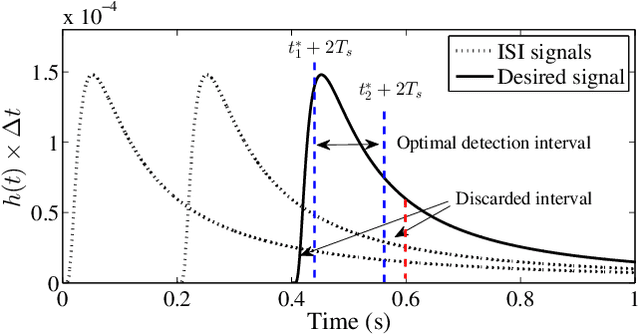
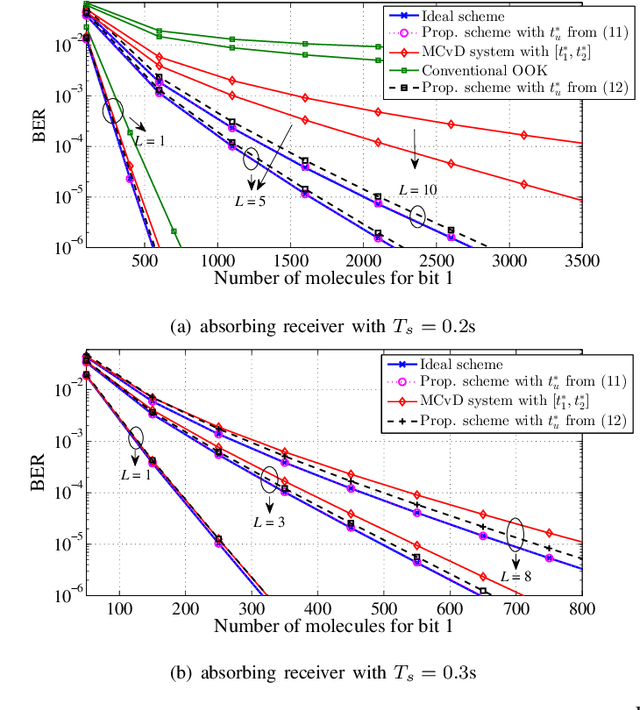
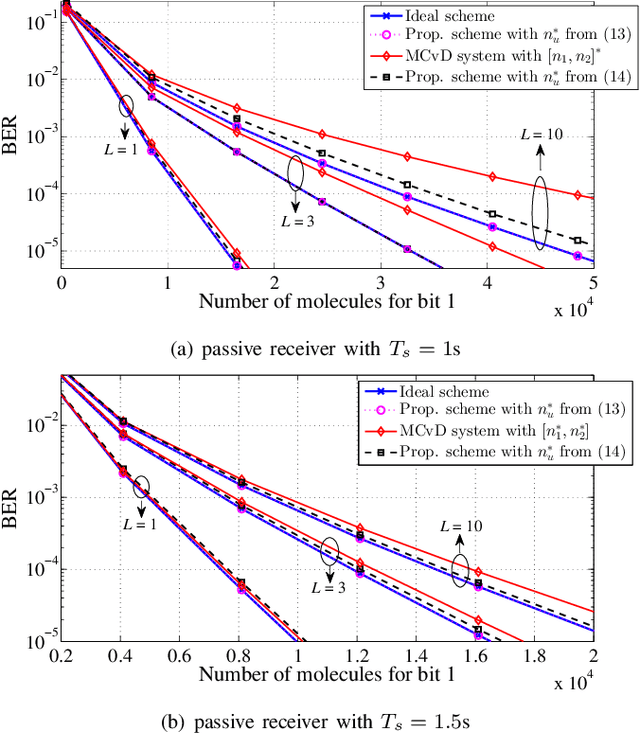

Abstract:In this paper, we propose a novel inter-symbol interference (ISI) mitigation scheme for molecular communication via diffusion (MCvD) systems with the optimal detection interval. Its rationale is to exploit the discarded duration (i.e., the symbol duration outside this optimal interval) to relieve ISI in the target system. Following this idea, we formulate an objective function to quantify the impact of the discarded time on bit error rate (BER) performance. Besides, an optimally reusable interval within the discarded duration is derived in closed form, which applies to both the absorbing and passive receivers. Finally, numerical results validate our analysis and show that for the considered MCvD system, significant BER improvements can be achieved by using the derived reusable duration.
An Extended Kalman Filter for Distance Estimation and Power Control in Mobile Molecular Communication
May 19, 2022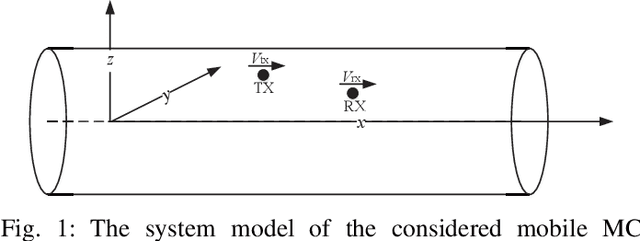
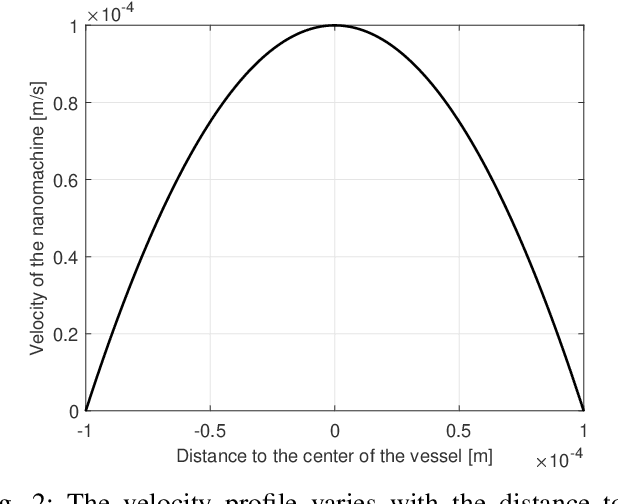
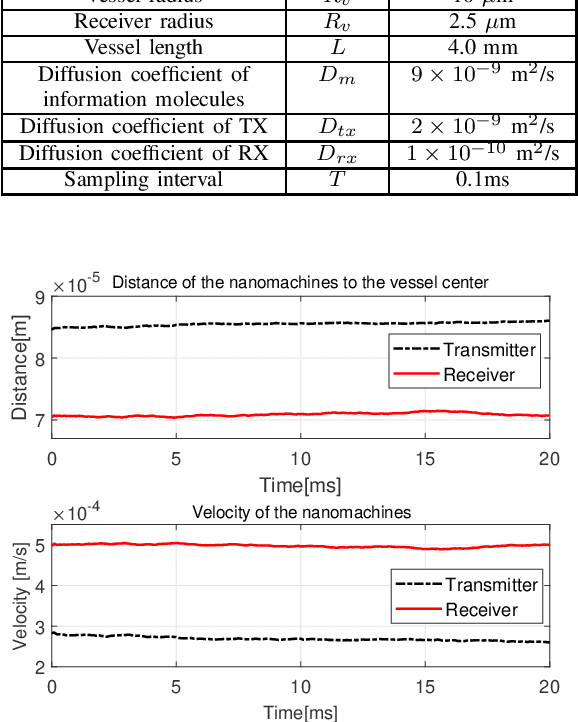
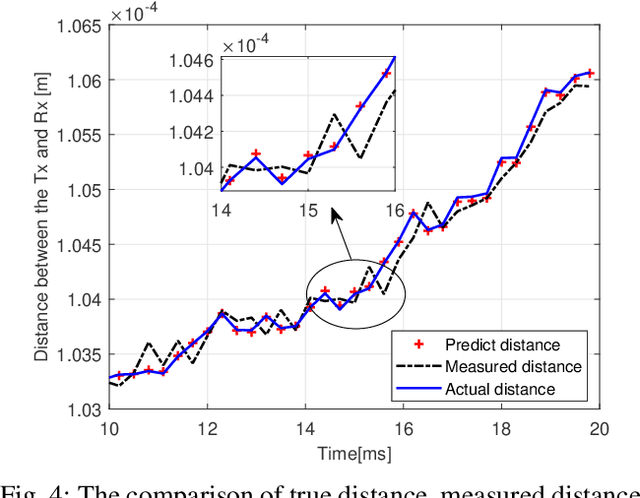
Abstract:In this paper, we consider a mobile molecular communication (MC) system consisting of two mobile nanomachines, a transmitter and a receiver, propelled by a positive drift velocity and Brownian motion in a realistic blood-vessel-type flow regime. Considering the nonlinear movement of the nanomachines, an extended Kalman filter is employed to estimate the distance from the transmitter. Furthermore, based on the predicted distance, to keep the number of received molecules for bit 1 at a stable level, we employ power control on the number of transmitted molecules based on the distance between the transmitter and the receiver and the residual molecules in the channel from the previous transmission. Finally, the optimal detection threshold is obtained by minimizing the error probability. It is verified that a fixed optimal detection threshold can be effective for the power control scheme in the mobile MC. The bit error rate (BER) performance of our scheme is verified via simulation results.
 Add to Chrome
Add to Chrome Add to Firefox
Add to Firefox Add to Edge
Add to Edge